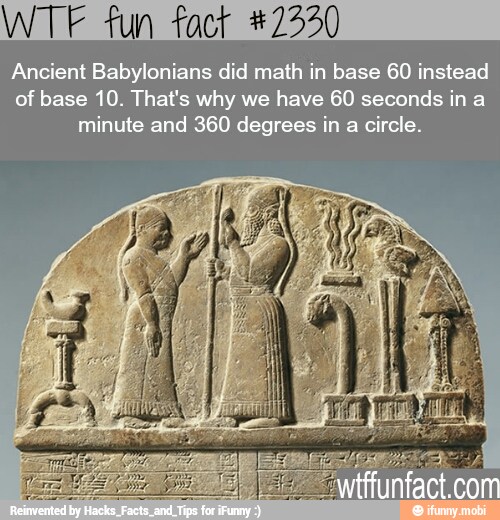


Britannica Explains In these videos, Britannica explains a variety of topics and answers frequently asked questions.This Time in History In these videos, find out what happened this month (or any month!) in history.Unlike the decimal system where you need to learn 10 symbols, Babylonians only had to learn two symbols to produce their base 60 positional system. #WTFact Videos In #WTFact Britannica shares some of the most bizarre facts we can find. 60 in Babylonian numeral is Babylonians inherited their number system from the Sumerians and from the Akkadians.Demystified Videos In Demystified, Britannica has all the answers to your burning questions.Britannica Classics Check out these retro videos from Encyclopedia Britannica’s archives.These pages are maintained by M.I.Woodcock. Links to other History of Mathematics sites This gave the finishing touch to the sexagesimal system - the value of every written number was now completely determined. The Alexandrian astronomer Ptolomy (C2 AD) used the symbol 0 for zero not only between digits but also at the end of a number. This system was used by astronomers - divided the degree into 60 minutes and minutes into 60 seconds. Serious drawback - no symbol for zero, to overcome this difficulty the Babylonians introduced a special symbol to indicate an empty space. The Babylonians, who were famous for their astrological observations and calculations (aided by their invention of the abacus ), used a sexagesimal (base-60). Systematic use of a place value notation has great advantages in computations and the Babylonians base of 60 has special advantage because it has so many factors. All Babylonian numbers were formed in base 60, so there are 59 different. The Babylonian system of writing numbers is a place value system, value of wedge depends on its position. All Babylonian number symbols are in cuneiform script, and are formed by marks. For example, the Babylonians used a base 60 number system but with only two. Later the same symbols and were also used to denote fractions When a Number System Loses Uniqueness: The Case of the Maya - Number Bases.
:max_bytes(150000):strip_icc()/plate018-56aab2fa5f9b58b7d008deb1.jpg)
All powers of 60 were denoted by a single wedge and ten times a power of 60 by an L shaped wedge In later times the notation was simplified further. Obviously first symbol is 60 because they would write largest unit first. Question - how could the Sumerians and Babylonians distinguish between 1 and 60? Sometimes from the position of the wedge and sometimes from context. second common system was the base-60 numeration inherited from the Babylonians via the Greeks and known as the arithmetic of the astronomers. With the later cuneiform numerals 1 and 60 were both represented by a simple wedge In the original form the symbols for 1 and 60 would be distinguished Sumerian and Babylonian Numerals Sumerian and Babylonian NumeralsĬlosely linked - treat as one civilisation.


 0 kommentar(er)
0 kommentar(er)
